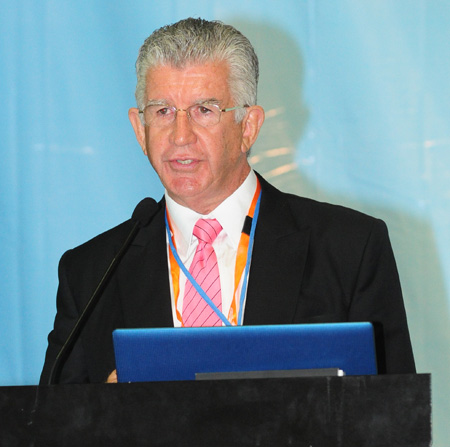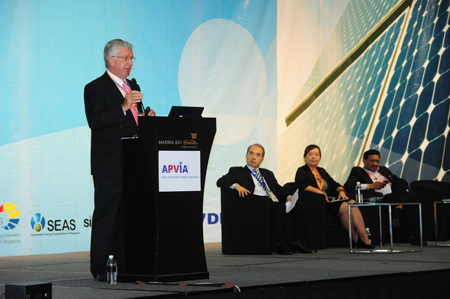
(Picture Credit: EMA)
Experts from the Asian Development Bank (ADB), India, China and Thailand led a detailed discussion on pan-Asian solar markets at the inaugural PVAP Financial Summit taking place during SIEW 2012.
Moderator Gil-Hong Kim, Director of Sustainable Infrastructure at the ADB, pointed out that huge energy requirements, limited fossil fuel resources and the need for energy security have made solar energy attractive in China, India and Thailand. Also, abundant solar irradiation coupled with falling PV module prices have brought solar PV energy closer to grid parity (expected in 2016-2017) in these regions.
Many regions such as Gujarat in India (which relies heavily on imported LNG) and the western China region are at or very close to grid parity. However, while the desire to install solar PV plants is there, a few common barriers are limiting its growth: Limited institutional involvement; limited capacity for public-sector R&D and project implementation; limited availability of debt finance; perceived high risks by the financial sector; and low credibility of the sector.
Delegates heard that in 2011, solar PV was the fastest-growing renewables technology worldwide. The operating capacity of solar PV, on average, grew 58 percent over the past five years. By the end of 2011, solar PV modules were priced at US$1-1.20 per watt, 76 percent below average prices in mid-2008.
While 2011 was a very good year for solar PV consumers and installers, solar PV manufacturers suffered. Although demand was up, profit margins declined due to falling prices, while excess inventory piled up even as government support declined. In addition, industry consolidation, the international financial crisis and tensions in international trade all threatened the profits and survival of many hardware manufacturers.
V Saibaba, CEO, Lanco Solar Pvt Ltd, said the Indian power market is growing fast to support the increased energy demand required to maintain its annual 7 percent GDP growth target. India has few fossil fuel resources. It imports more or less 100 percent of oil and gas. The majority of its coal reserves are under forest cover and deep underground, making it difficult and expensive to mine.
Against this backdrop, the potential for solar energy is huge: India gets on average 250 to 300 sunny days per year. It has large desert land in parts, such as Gujarat and Rajasthan, which can be tapped. India also currently has a 10 percent shortage in its peaking capacity, which can be addressed through solar power.

(Picture Credit: EMA)
The government of India launched the national solar mission to develop 20GW by 2020. To support this mission, it has introduced several mechanisms: Renewable feed-in-tariff (FiT); renewable energy certificates (RECs) (this is an obligation on every utility company to meet 3 percent of energy requirements from solar by 2020); and capital allocation (small-scale and rural projects). If all utilities meet their 3 percent obligation, the size of the market could be larger than 20GW. KPMG estimates that market could be as large as 60GW by 2020.
Saibaba said the challenges to the solar market include: More debt funding needed to meet heavy capital requirements; more masts needed countrywide to provide reliable solar irradiation data; increasing awareness, education and confidence of the banking industry needed towards solar power; poor utilities credit rating hurting project bankability; and banks hitting their exposure limits to the power sector and preventing them from lending to solar projects.
Lu Fang of the Chinese Renewable Energy Society said China is the world's largest PV market with 2.1GW of operating capacity. The success of PV in China can be directly linked to the introduction of the national FiT policy. The current FiT tariff for solar PV is 1 yuan/kWh (1.15 yuan/kWh for projects in operation before 31 Dec 2011), higher than wind and bio-power.
A total of 9GW of solar PV projects were approved in 2012 under FiT and the special renewable energy scheme. The target for 2015 is 21GW. The key issues in China relate to the lack of clarity on the length of the FiT tariff and the lack of a relationship between the tariff and capacity installation scale.
China, he said, is also on the verge of bringing out regulation to encourage distributed PV. This is expected to promote more self-consumption instead of electricity being fed back into the grid. However, grid-connected PV is still 90 percent of the PV market in China.
Kevin Parnell, Board of Director, SPCG Public Co, pointed out that Thailand has one of highest per-capita power consumption across Asia and this is expected to grow. It is Asia's leading centre for centralised manufacturing industries and the world's 9th-largest car manufacturer. With factories that are spread throughout the rural area and thriving, demand for power has increased substantially.
Overall, the forum heard that there is significant demand and potential for solar power generation in the three countries. However, barriers limiting large-scale development loom large. Governments, stakeholders and the private sector need to work together to overcome these barriers. Kim said the ADB is committed to solar energy and working together with various entities to ensure the population in these countries gets access to energy. ADB invested US$300 million in solar energy in 2011, and expects this level to continue going forward.
By :Neha Shah, INSEAD